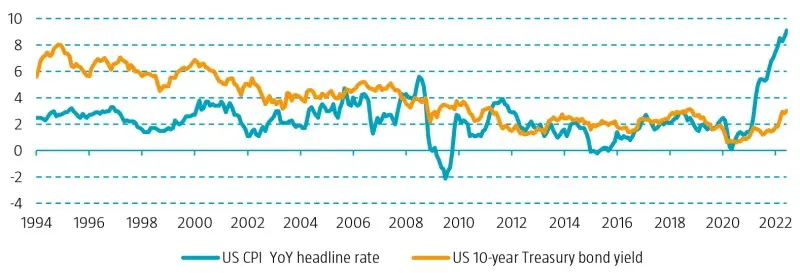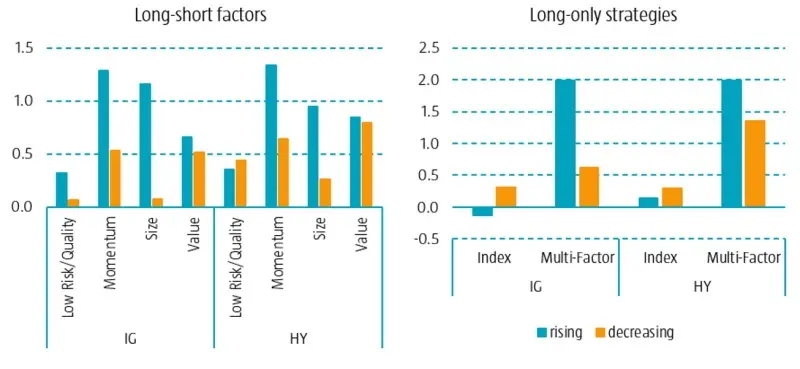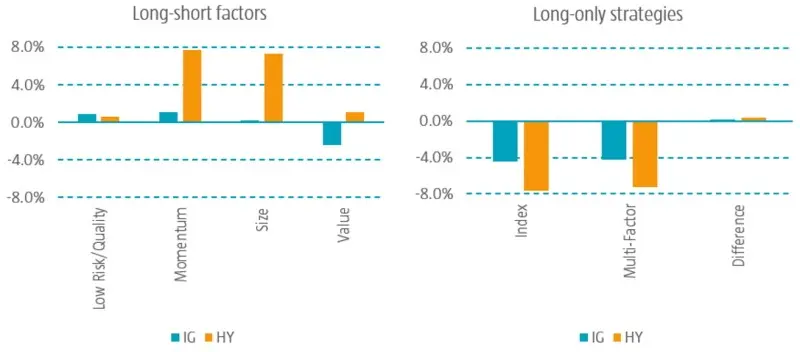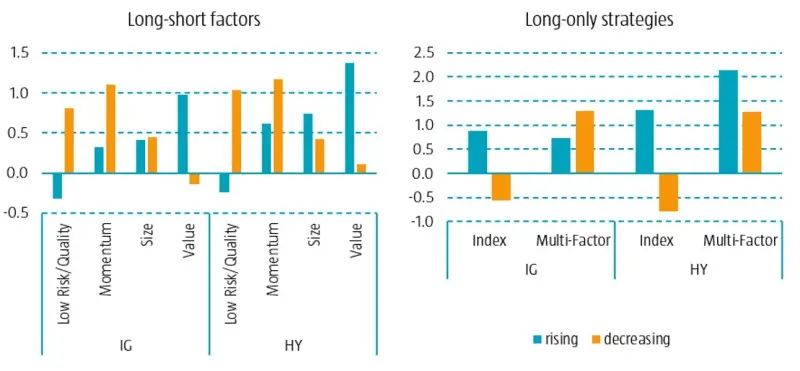Inflation worries and rates surges have afflicted markets over the last twelve months. Inflation has moved higher, driven to a large extent by the strong post-Covid economic recovery and the war in Ukraine. Developed market central banks have reacted firmly by, among others, implementing rate hikes not seen in decades. Market interest rates have surged in response.
In a previous article,1 we showed that multi-factor corporate bond strategies provide all-weather performance across inflation regimes. We use the recent extreme inflation developments to reassess the robustness of our findings. Given the sharp increase in interest rates over the same period, we extend our analysis to rates dynamics.
Overall, we reconfirm that multi-factor credit strategies provide all-weather outperformance, not only across inflation regimes, but also in various interest rate environments. Our conclusions are robust in the investment grade as well as high yield investment universes. As individual factors do show some sensitivities to the macro environment, we find that investors’ alpha is best protected against macro dynamics when combining factors in a multi-factor portfolio.
Inflation and rates changes have been extreme by historical standards
Inflation and rates changes over the past year have been extreme by historical standards and are in the top 5% of their respective historical distributions. Figure 1 shows that US headline CPI inflation has hovered around 2% for most of the sample period, in line with the Fed’s inflation target. However, it rose to 5.1% in June 2021 and then surged to 9.1% in June 2022, the highest level in 30 years. The US 10-year yield rose from below 1.5% in June 2021 to above 3% in June 2022, reaching one of the highest levels over the past 10 years, as the Fed hiked rates to contain inflation pressures.
Figure 1 | Inflation and interest rates dynamics

Source: Robeco, Bloomberg.
Period: January 1994-June 2022.
Over the past 12 months, our Robeco QI Global Multi-Factor Credits and Robeco QI Global Multi-Factor High Yield flagship funds (henceforth GMFC and MFHY) outperformed their benchmark by respectively 21 bps and 33 bps, in conditions that were difficult for credit markets – as evidenced by the fact that both benchmarks lost about 14% in total return terms.2
Investigating the macro sensitivity of factor premiums
We analyze the low-risk/quality, value, momentum and size factors, which are an integral part of our multi-factor investment process. These have been well documented in the academic literature and in numerous white papers.3 We use Robeco’s enhanced factor definitions and rely on data from January 1994 to June 2022, covering the global investment grade and global high yield universes separately.
In Figure 2, we investigate the sensitivity of factor premiums to unexpected inflation changes. The chart on the left shows the Sharpe ratios of the individual long-short factor portfolios conditional on a rising or decreasing inflationary regime, for both investment grade and high yield. We see that the Sharpe ratios of the factors vary with the regime and are generally lower in regimes of decreasing inflation. Furthermore, we find that the Sharpe ratios are positive in all environments.
Figure 2 | Sensitivity of factor Sharpe and information ratios to unexpected inflation changes

Source: Robeco, Bloomberg.
Period: January 1994-June 2022.
In the chart on the right, we investigate the sensitivity of the Sharpe ratios of the market indices, and the information ratios of the multi-factor strategies. We find that the returns of the investment grade credit market are higher when inflation increases unexpectedly, while the Sharpe ratio of the high yield market seems insensitive to unexpected inflation changes. The long-only multi-factor strategies deliver highly significant information ratios in all environments, for both investment universes, that are higher when inflation surprises on the upside. The higher information ratios are mostly the result of lower tracking errors in inflationary regimes, while the outperformances are hardly affected.
In Figure 3, we display the individual long-short factor premiums, the market returns and the outperformance of the multi-factor strategies over the last 12 months, in both investment grade and high yield markets. During that period, we experienced extreme inflationary pressures with nine months of rising inflation. As shown in the left chart, we find that, on the one hand, most of the factors exhibiting positive premiums in inflationary regimes in the full sample analysis also displayed positive performance out of sample, with the exception of the value factor in investment grade. On the other hand, the magnitude of the factor premiums was smaller than expected. One potential explanation for this behavior is that inflation was not the only dynamic at play and that other concerns (e.g. the risk of a recession) also influenced the factor premiums.
Figure 3 | Out-of-sample evidence on the factor premiums in inflationary regimes

Source: Robeco, Bloomberg.
Period: June 2021-June 2022.
In the right chart with the long-only results, we investigate the market returns and the outperformances of the multi-factor strategies. We see large negative credit returns of the investment grade and high yield markets, which were concentrated in months with unexpected inflation increases. The long-only multi-factor strategies delivered small positive outperformance in an inflationary environment for both investment universes.
Overall, we see from the above results that the very extreme unexpected inflation changes over the last year did not alter our conclusions. The outperformance over that period of our flagship products GMFC and MFHY provides further out-of-sample evidence of the ability of a multi-factor approach to deliver alpha in a rising-inflation environment.
Interest rate sensitivities
When considering changes in interest rates, we follow the same methodology as for the above analysis on inflation sensitivities. We are now interested in the coincident relationship between factor premiums and changes in interest rates, over the same measurement period.
In Figure 4, the left graph again shows the Sharpe ratios of the individual long-short factor portfolios. We see this time that individual factor premiums are sensitive to the interest rate regime: when interest rates are rising, the low-risk/quality factor underperforms and the value factor performs strongly. Size, on the other hand, seems to be agnostic to changes in interest rates, while momentum earns a higher premium in a decreasing-rate environment. The performance differences between the factors suggest that combining factors in a multi-factor model might offer a more robust all-weather performance.
Figure 4 | Sensitivity of factor Sharpe and information ratios to interest rate changes

Source: Robeco, Bloomberg.
Period: January 1994-June 2022.
In the chart on the right, we show our findings on the sensitivity of the Sharpe ratios of the market indices and the information ratios of the multi-factor strategies. We find that the credit returns of the investment grade credit and high yield markets are markedly different across interest rate regimes. They are positively associated with rate changes, increasing (decreasing) when the interest rates are rising (falling). More importantly, the long-only multi-factor strategies deliver highly significant information ratios in all environments, for both investment universes. The differences in information ratios are mostly the result of tracking error variations across interest rate regimes, while the outperformances are hardly affected.
Conclusion
Overall, credit factors are more sensitive to changes in interest rates than to inflations dynamics. Nevertheless, multi-factor solutions offer consistent outperformance across regimes by exploiting the diversification in factor premiums across states. Ultimately, we find that investors’ alpha is best protected against changing macroeconomic conditions when combining factors in a multi-factor portfolio.
免責聲明
本文由荷宝海外投资基金管理(上海)有限公司(“荷宝上海”)编制, 本文内容仅供参考, 并不构成荷宝上海对任何人的购买或出售任何产品的建议、专业意见、要约、招揽或邀请。本文不应被视为对购买或出售任何投资产品的推荐或采用任何投资策略的建议。本文中的任何内容不得被视为有关法律、税务或投资方面的咨询, 也不表示任何投资或策略适合您的个人情况, 或以其他方式构成对您个人的推荐。 本文中所包含的信息和/或分析系根据荷宝上海所认为的可信渠道而获得的信息准备而成。荷宝上海不就其准确性、正确性、实用性或完整性作出任何陈述, 也不对因使用本文中的信息和/或分析而造成的损失承担任何责任。荷宝上海或其他任何关联机构及其董事、高级管理人员、员工均不对任何人因其依据本文所含信息而造成的任何直接或间接的损失或损害或任何其他后果承担责任或义务。 本文包含一些有关于未来业务、目标、管理纪律或其他方面的前瞻性陈述与预测, 这些陈述含有假设、风险和不确定性, 且是建立在截止到本文编写之日已有的信息之上。基于此, 我们不能保证这些前瞻性情况都会发生, 实际情况可能会与本文中的陈述具有一定的差别。我们不能保证本文中的统计信息在任何特定条件下都是准确、适当和完整的, 亦不能保证这些统计信息以及据以得出这些信息的假设能够反映荷宝上海可能遇到的市场条件或未来表现。本文中的信息是基于当前的市场情况, 这很有可能因随后的市场事件或其他原因而发生变化, 本文内容可能因此未反映最新情况,荷宝上海不负责更新本文, 或对本文中不准确或遗漏之信息进行纠正。
